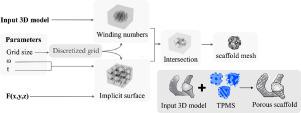Computer Methods and Programs in Biomedicine ( IF 4.9 ) Pub Date : 2021-04-06 , DOI: 10.1016/j.cmpb.2021.106088 Jirawat Iamauthsamang , Phornphop Naiyanetr

|
Background and objective
The triply periodic minimal surface (TPMS) method effectively mimics the porous scaffold for tissue engineering with continuous topology, pore interconnections, and high surface area to volume ratio. However, the process to generate a three-dimensional (3D) mesh of porous structure from the mimicked organs is complicated for biologists and sometimes requires various software. Herein, we present the standalone program called "Scaffolder" for generating the porous topology from the user-input 3D model to the open-source community.
Methods
The 3D mesh of a porous scaffold was used by the proposed method and dual-marching cubes algorithm. Afterward, the mesh was sliced into the contours to examine pore sizes by Feret diameter and Gilbert–Johnson–Keerthi distance. The relationships between the program parameters (i.e., grid size, angular frequency, and iso-level) and scaffold properties (i.e., pore size, porosity, and surface area ratio) were investigated.
Results
The developed program can generate and evaluate a porous scaffold. The median (IQR) absolute errors in grid size of 200, 300, 400, and 500 divisions were 1.92 (0.35-3.80), 1.00 (0.18-2.22), 0.53 (0-1.37), and 0.24 (0-0.74), respectively. Spearman's correlation showed the impact of angular frequency and iso-level on the pore size, porosity, and surface area of the generated scaffold (p<0.05).
Conclusions
This study enables researchers to rapidly design the 3D mesh of porous scaffold design, evaluate scaffold properties, and customize the implicit function for various applications, especially in tissue engineering and computational structural analysis.
中文翻译:

基于隐式表面生成多孔支架的计算方法和程序
背景和目标
三重周期性最小表面(TPMS)方法有效地模拟了具有连续拓扑结构,孔互连和高表面积体积比的组织工程用多孔支架。但是,从模仿的器官生成多孔结构的三维(3D)网格的过程对于生物学家来说很复杂,有时需要各种软件。在这里,我们介绍一个名为“ Scaffolder”的独立程序,用于从用户输入3D模型到开源社区生成多孔拓扑。
方法
通过所提出的方法和双重行进立方体算法,使用了多孔支架的3D网格。然后,将网格切成轮廓,以费雷特直径和吉尔伯特-约翰逊-基尔蒂距离检查孔径。研究了程序参数(即,网格大小,角频率和等值线)与支架特性(即,孔径,孔隙率和表面积比)之间的关系。
结果
开发的程序可以生成和评估多孔支架。200、300、400和500格的网格中位数(IQR)绝对误差为1.92(0.35-3.80),1.00(0.18-2.22),0.53(0-1.37)和0.24(0-0.74),分别。Spearman的相关性显示角频率和等值线对所产生支架的孔径,孔隙率和表面积的影响(p <0.05)。
结论
这项研究使研究人员能够快速设计多孔支架设计的3D网格,评估支架特性并为各种应用定制隐式函数,尤其是在组织工程和计算结构分析中。











































 京公网安备 11010802027423号
京公网安备 11010802027423号